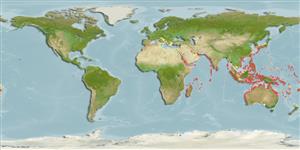Gastropoda |
Nudibranchia |
Chromodorididae
Environment: milieu / climate zone / depth range / distribution range
Ecology
Benthic. Tropical
Indo-Pacific and the Mediterranean Sea.
Length at first maturity / Size / Weight / Age
Maturity: Lm ? range ? - ? cm Max length : 4.0 cm TL male/unsexed; (Ref. 844)
Assumed maximum length from Ref. 844. Found in the intertidal and shallow subtidal habitats on tropical reefs (Ref. 866). Carnivorous. Possibly feeds on sponges (Also Ref. 129713) as it is reported to be observed on sponges under rock slabs and boulders in the lower eulittoral and sublittoral fringe (Ref. 102838). Members of the family Chromodorididae feed on sponges (Ref. 108647).
Life cycle and mating behavior
Maturity | Reproduction | Spawning | Eggs | Fecundity | Larvae
Members of the order Nudibranchia are simultaneous hermaphrodites. Mating behavior: Both individuals darts their penis toward each other to induce one to act as a male and the other as the female. The victorious one to penetrate the body wall is the dominant male. Life cycle: Eggs are deposited on a substratum where they develop and hatch into (planktonic) vestigial veliger larval stage and further grow as adults.
Debelius, H. 2001 Nudibranchs and sea snails: Indo-Pacific field guide. Unterwasserarchiv, IKAN, frankfurt, Germany, 3rd ed. 321 pp. (Ref. 844)
IUCN Red List Status
(Ref. 130435: Version 2025-1)
CITES status (Ref. 108899)
Not Evaluated
Not Evaluated
Threat to humans
Harmless
Human uses
| FishSource |
Tools
More information
Population dynamicsGrowth
Max. ages / sizes
Length-weight rel.
Length-length rel.
Length-frequencies
Mass conversion
Abundance
Life cycleReproductionMaturityFecunditySpawningEggsEgg developmentLarvae PhysiologyOxygen consumption
Human RelatedStamps, coins, misc.
Internet sources
Estimates based on models
Preferred temperature
(Ref.
115969): 16.3 - 29.2, mean 26.7 (based on 2231 cells).
Fishing Vulnerability
Low vulnerability (10 of 100).
Price category
Unknown.
